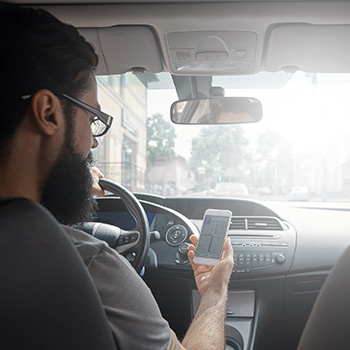The Science Behind Distracted Driving
A recent DMEautomotive poll found that drivers perform all kind of distracting activities, including reading an email or newspaper, flossing or brushing their teeth, changing their clothes, and taking photographs. Distracted driving can involve more than just your cellphone. Three types of distracted driving exist: visual, cognition, and physical, which you can learn more about here.
Why do we focus on cellphone use while driving?
People tend to focus on on the dangers of cellphone, particularly smart phone, use behind the wheel. One look at the statistics will explain why. According to distraction.org, the number of smartphone owners increased from 52% of drivers in 2011 to 80% in 2014. According to distracteddriveraccidents.com, over 50% of car crashes involve cell phone use, and 25% involved texting while driving. The CDC reports that up to 8 people die each day in distracted driving related crashes.
 The exact numbers change depending on the survey, study, or poll but it’s clear that distracted driving, with cell phone use in particular, is one of the deadliest threats 21st century Americans face. Most drivers are aware of how dangerous texting while driving or glancing at an email behind the wheel can be, yet at any given point during daylight hours 660,000 drivers are fiddling with an electronic device behind the wheel.
The exact numbers change depending on the survey, study, or poll but it’s clear that distracted driving, with cell phone use in particular, is one of the deadliest threats 21st century Americans face. Most drivers are aware of how dangerous texting while driving or glancing at an email behind the wheel can be, yet at any given point during daylight hours 660,000 drivers are fiddling with an electronic device behind the wheel.
Yet even more people misunderstand distracted driving. Research has shown that hands-free devices are no safer than hand-held ones. Drivers who are talking on their cell phone are 4x more likely to crash — drunk drivers share those odds. The odds of crashing if you’re texting while driving is 8x times the normal rate, meaning it doubles the crash likelihood of driving drunk.
Despite the fact that 94% of drivers support a texting while driving ban, 75% text while driving. When this behavior kills thousands each year, people justifiably want to know why drivers persist in this dangerous habit.
Why do people text and drive?
Irresponsibility cannot be the only factor creating people who are willing to risk their life and the life of those around them to check a text. While no definitive answer exists, there are two factors that might explain why people text and drive.
Texting gets you high
Science has started to dip its toes into why people text and driving or perform otherwise distracting activities while behind the wheel. According Dr. Paul Atchley, one underlying factor could stem from the fact texting or posting on social media releases a small dopamine boost inside a human’s brain. It’s believed that small chemical change impairs our judgement, almost like a drug, and overrides the known dangers of texting while driving. As a result, people are still willing to type out those texts despite understanding the dangers.
Self-deceiving brains
The doctor also said drivers overestimate their driving capabilities- another famous example of the human brain’s self-deception. Most people think they are capable of multitasking, which means it’s not dangerous to drive while performing another activity, but cognitive neuroscientist, David Strayer, says only about 2.5% of the population can actually do so.
Many drivers consider themselves “safe” and think they can handle the situation they are experiencing, leaving their brains free to wander. Even if a driver isn’t performing another task, his or her brain could wander away from the road. Psychologist Daniel Simons described such a phenomenon saying, “That’s why you can drive home and not remember having driven home”. This sort of false safety and confidence people have in their driving leads them to believe driving distracted isn’t too dangerous for his or herself. Drivers fail to realize that “multitasking” is actually their brain switching back and forth between tasks rapidly. You cannot focus on driving and another task at the same time, even if it’s just a glance. In fact, the average text takes 5 seconds to read. If a driver is traveling at 55 mph, he or she then drives the equivalent length of a football field blindfolded.
How to stop driving distracted
While many states have legal measures they can take against people texting while driving, there are many ways a driver can try to regulate his or herself. Plenty of apps created to stop texting and driving exist and lots of good advice on how to stop driving distracted does too.
In the end, driving with any form of distraction is a choice. Everyone can choose to glance at the screen or respond to a text while sitting at a red light. April is Distracted Driving Awareness month, making now the perfect time to consider the consequences of distracted driving. Only you can decide if the steep cost of your life or someone else’s is worth the risk.
Categorized in: Driving, Safety Tips
